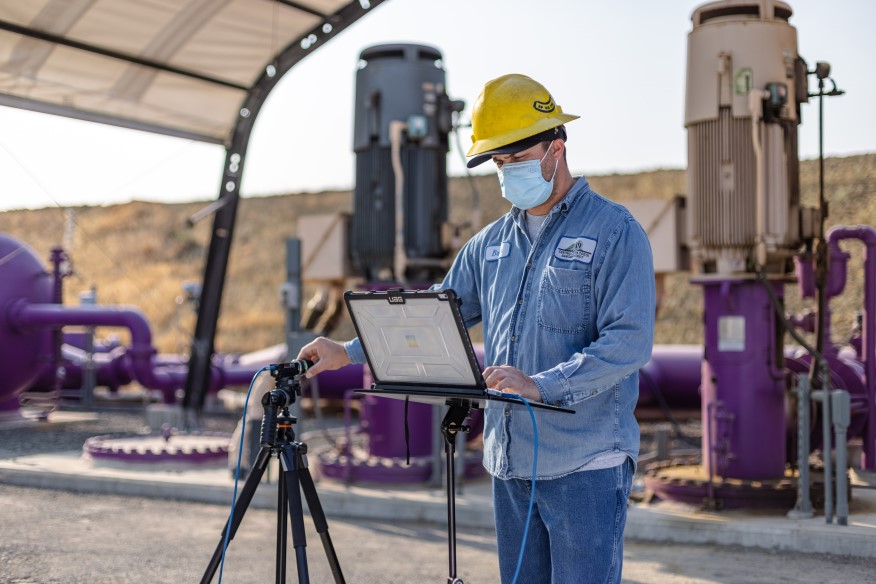AC22 Highlight: Central San to Present Projects, Celebrate 75 Years of Optimization and Innovation
AC22 Hot Topic Preview: Deep Dive Session on Wednesday, April 13
By Christina Gee, Management Analyst, Central San, Members in the News
Wednesday, April 13th Technical Session
Class details and registration info >
Every two years, Central San adopts a Strategic Plan as a roadmap to accomplish the goals set by the Board of Directors. For 2020-2022, Central San’s goal of INNOVATION AND OPTIMIZATION: Explore new technologies for continuous improvement has set forth the strategies, initiatives, and key success measures to drive optimizations and innovations to manage costs and embrace technology.
A TRADITION OF INNOVATION AND OPTIMIZATION
Central San has a long history of finding better ways to doing things. Its employees have been instrumental in developing and piloting equipment and processes that continue to shape the wastewater industry such as:
- The overflow protection device as a solution to help mitigate overflows. Invented by two employees and patented in 1960, the device has prevented untold property damages and repair expenses and is still used by wastewater utilities throughout the nation.
- Pipe-bursting sewer construction technology to replace aging pipes. In 1987, Central San became the first utility in the United States to use this technique, where a piece of equipment (affectionately nicknamed “the mole”) bursts and disintegrates old pipe, pushes back surrounding earth, and pulls in new pipe – all in one smooth operation. To this day, this significantly reduces construction impacts to roads, traffic, and customers.
- Ultraviolet (UV) light for wastewater disinfection. Central San was a pioneer in pilot testing the new technology in 1992 as a safer alternative to chlorine. When Central San’s UV facility was completed and placed into operation in 1997, it was the largest UV disinfection plant in the country.
CURRENT EFFORTS
Some of Central San’s optimization projects which are currently underway or in the works include the following:
- Installing 10 maintenance access hole monitors from Smart Cover and ADS (five from each brand), as part of a one-year pilot project to evaluate and predict collection system flows and avoid spills.
- Using its Pipeline Cleaning Schedules Web Application to constantly review and improve pipeline cleaning schedules based on schedule frequency intervals and location. Staff can see information on each pipe, project out seven years, and schedule mains to manage distribution of resources.
- Launching a Large Diameter Pipeline Inspection Program to assess the condition and location of its interceptors (more than half of which are over 50 years old) using state-of-the-art multi-sensor technology such as lidar and 3-D underground mapping. These sophisticated sensors travel through the pipelines on robotic platforms, collecting data as they go, allowing Central San to better plan for needed repairs and replacements.
- Beginning a tertiary membrane and reverse osmosis filtration pilot project to test whether this filtration might provide better performance than Central San’s current filters. Currently, there are four gravity/sand filters in place rated up to 3 million gallons per day that have not performed optimally. In addition, these filters require a lot of coagulant aid, alum, and a considerable amount of backwash maintenance.
“We believe optimizations can come in all sizes and that even the smallest of adjustments can have a significant impact.” – General Manager, Roger S. Bailey
IMPROVING INFRASTRUCTURE THROUGH OPTIMIZATION
Central San continuously studies and pilot tests potential optimizations to infrastructure and maintenance practices to rehabilitate and replace equipment and execute its robust Asset Management Program.
- Central San saved about $1 million in capital costs and $15,000 annually in future cleaning and maintenance by reducing the amount of pipe needing replacement. This was done by installing 47 private sewer laterals by pit-launched horizontal directional drilling, to reverse the flow from backyard mains to be abandoned to new mains installed in the streets.
- Each Plant Maintenance Shop has formed an Asset Condition Monitoring Team to develop and implement procedures for thermography, ultrasound, vibration, laser alignment, high-speed camera motion amplification, fluid analysis, and motor winding analysis. These technologies can continually monitor essential equipment for proper maintenance.
- Part of Central San’s Asset Condition Management Program, an Ultrasound Testing Program was launched to identify and implement energy savings, help avoid equipment downtime, increase reliability, enhance acceptance testing, and allow advanced diagnostics and trending to aid in the Preventative Maintenance (PM) Program. The program is currently being used as a diagnostic tool on induced draft fans, centrifuges, and return activated sludge pump motors. Staff are being trained and certified, have created Ultrasound Inspection Forms in the Cityworks computerized maintenance management system, and are working on creating a predictive maintenance task for the steam assets.
Join Central San during AC22 in Sacramento as they share lessons learned during their capital program, sustainability, and smart utility efforts on Wednesday, April 13.
Strategic Long-term Capital Improvement Planning (ICP)
Wednesday, April 13, 2022
8:30 AM – 9:20 AM
Case Study: Lessons Learned, Moving Control System Architecture from 20th to 21st Century
Wednesday, April 13, 2022
9:30 AM – 10:20 AM
